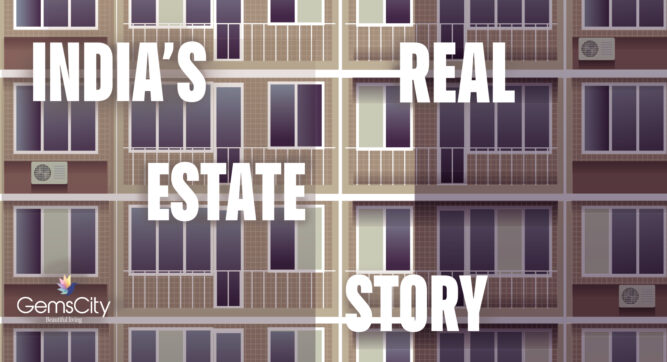BlogsAll about beautiful living
- Categories
India’s real estate story – a snapshot by Gems Group

The story of India’s real estate sector must really begin from the olden days when land was owned by communities. This was followed by the king’s ownership, which was absolute. He could grant land to temple priests, powerful nobles and employees in return for services.
Rulers and wealthy landlords began engaging in the building of palaces, forts, and places of worship, public rest-houses and baths right until the Mughal era, leading to the development of a real estate industry.
The British colonial period saw the development of urban centres such as Mumbai, Kolkata and Chennai, with the construction of railway networks, ports and administrative buildings.
After India gained independence in 1947, the real estate sector gained significant impetus from a number of government initiatives, which can be regarded as its milestones.
Public housing
In 1950-60, the Indian government launched several public housing projects to provide affordable housing for low-income families. These aimed at reducing the housing shortage in urban areas and improving living conditions.
Residential colonies
Government and government undertakings constructed residential colonies for their employees in major cities. These colonies were equipped with amenities such as schools, hospitals and parks.
Land reforms
Introduction of reforms in 1950-60 aimed at redistributing land to the landless, tenant farmers and rural labourers. These had a significant impact on the rural real estate sector and led to the emergence of new players in the industry.
Urban growth & infrastructure
The government invested heavily in the construction of roads, bridges and ports, to improve connectivity and support economic growth. This led to the development of new urban centres and increased demand for real estate in these areas. In 1952 and 1960, the new capital cities of Chandigarh and Gandhinagar were established. More people moving to cities for employment opportunities drove demand for urban housing and commercial real estate.
Entry of private players
In 1980-90, private players entered the real estate space, leading to a shift from public housing to private housing, and the development of new real estate segments, such as luxury housing and commercial real estate.
Economic liberalisation
Liberalisation of the Indian economy in the 90s led to an influx of foreign investment and expertise into the real estate sector. This resulted in the development of large-scale real estate projects, such as IT parks, shopping malls and entertainment complexes. Skyscrapers began springing up in Mumbai, Delhi, Kolkata and Chennai designed by international architects hired by Indian developers.
Foreign Direct Investment
FDI was made possible in 2005, making it simpler for foreign developers to fund Indian real estate projects. In 2006, the Indian government approved the use of the public-private partnership model to modernise brownfield airports such as Mumbai and New Delhi and green-field airports such as Bengaluru. This resulted in a significant boom in real estate development around airports.
Digital platforms
In recent years, with the advent of online real estate portals and property listing platforms it has become easier for buyers, sellers and renters to find, transact and get better deals online.
RERA
Real Estate Regulatory Authority (RERA) arising from The Real Estate Regulation and Development Act, 2016, introduced a regulatory framework aimed at protecting the interests of buyers and promoting professionalism through transparency in the industry.
Low income housing
Since 2015, there have been several initiatives to promote affordable residential housing by the Govt. of India, such as Pradhan Mantri Awas Yojana (PMAY), which provides subsidies to low-income families to buy or build their own homes. This has boosted demand in low income housing.
Today, India’s real estate industry is one of the fastest-growing in the world, with a wide range of players – from small developers to large corporations. It continues to evolve with the introduction of new technologies and regulatory frameworks. Its resilience is reflected in how well it has bounced back after the drastic impact of COVID-19, which saw unparalleled slowdown worldwide.
Gems Group is a proud participant in India’s real estate industry. Its upcoming residential township, Gems City, near Joka Metro in Kolkata, is one of south Kolkata’s largest on-going development and Joka’s largest gated township.
You Might Like...
-
 21 April, 2024
21 April, 2024Embrace Affordable Luxury: Discover the Advantages of 3 BHK flats in Joka Gems City
Are you searching for a spacious and affordable home...more
-
 10 April, 2024
10 April, 2024Essence of Beautiful Living in South Kolkata’s most preferred residential complex
In the serene location of Joka, South Kolkata...more
